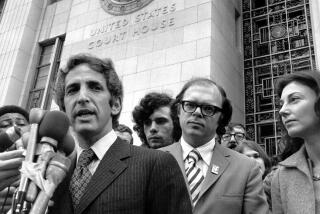Free the Bush memos
- Share via
On his second day in office, President Obama directed all of his administration’s employees to work toward “an unprecedented level of openness,” explaining that transparency would “strengthen our democracy and promote efficiency and effectiveness in government.”
Now the president can begin to make good on his promise of transparency by releasing the dozens of still-secret legal memos written by the Bush administration’s Office of Legal Counsel.
The Office of Legal Counsel, which is part of the Justice Department, provides authoritative legal opinions to the president and executive branch agencies. It tells the president what the law allows and, more important, what the law prohibits.
Dawn Johnsen, whom Obama has nominated to lead the once-obscure office and whose confirmation hearing was held Wednesday, wrote in a 2007 law review article that the office must be “prepared to say no to the president.” But under President Bush, the office played a very different role: Its senior lawyers served not as sources of bona fide legal guidance but as knowing facilitators of the president’s lawless conduct.
Office of Legal Counsel lawyers told Bush, for instance, that the 4th Amendment’s protection against unreasonable searches and seizures did not apply to military operations inside the United States. They also created a legal argument to justify the National Security Agency’s warrantless wiretapping program. And they produced memos that permitted the CIA to subject prisoners to waterboarding and other barbaric interrogation methods that the United States had in the past prosecuted as war crimes.
Lawyers for the office -- including John Yoo, Steven Bradbury and Jay Bybee -- churned out dozens of memos on torture, rendition, detention without charge and wiretapping without warrants. Many of their positions were founded on a conception of unbounded executive power previously articulated most succinctly by President Nixon: “When the president does it, that means it’s not illegal.” The memos simply ignored the Supreme Court decisions that rejected this theory.
Worse yet, some of the memos were plainly intended to insulate Bush administration officials from criminal liability. Jack Goldsmith, who as head of the Office of Legal Counsel felt compelled to withdraw some of the most extreme memos written by Yoo and others, has charged that the torture memos in particular, “in their redundant and one-sided effort to eliminate any hurdles posed by the torture law ... could be interpreted as if they were designed to confer immunity for bad acts.”
And, according to the Washington Post and other sources, a yet-to-be-released ethics report by the Justice Department’s Office of Professional Responsibility confirms that lawyers in the Office of Legal Counsel intentionally misrepresented or distorted the law to support the Bush administration’s policy goals.
How do we know what the Office of Legal Counsel was doing if the documents are still secret? Two of the memos have been released as a result of lawsuits filed by the ACLU and its partners; many other memos have been described in the government’s legal papers. And a few have been leaked to the media -- including, most notably, the memo that defined torture to encompass only those methods that inflict the kind of pain associated with organ failure or death.
But in general the Bush administration was remarkably successful at shielding the office’s work from the public. The documents most crucial to the historical record -- including many of the memos used to justify the administration’s most radical policies -- are still being withheld. The result is that the public lacks access to basic information about how the Bush administration’s national security policies were developed, who participated in their development and what legal arguments were generated to support them.
The Bush administration contended in court that the memos are protected by the attorney-client privilege or that they can’t be released without compromising the nation’s security. Historically, though, many of the office’s memos have been published as a matter of course. And it is not clear how national security would be harmed by releasing, for example, legal analyses of interrogation methods that are unlawful now and that were unlawful when they were used.
Given what we know about the policies the memos supported, it’s difficult to escape the conclusion that the memos were withheld by the Bush administration for purely political reasons -- to shield indefensible legal arguments from public scrutiny and to shield public officials from accountability.
At her confirmation hearing, Johnsen said she would urge that the still-secret memos be reviewed for release, but that they might be redacted or even withheld entirely for reasons of national security.
Limited redactions maybe be necessary in extraordinary cases, but national security should not be used as a pretext for the wholesale suppression of the memos. And there are good reasons to release the memos now. By releasing them, the Obama administration would signal that it truly intends to end an era in which the Justice Department became shamefully complicit in the most egregious crimes. Equally important, it would allow the public to better understand the policies that defined the Bush administration and shaped history, and to understand the role that the Office of Legal Counsel played in developing, justifying and advocating those policies.
In dozens of legal briefs, the Bush administration was never able to articulate a persuasive reason for withholding the memos from the public. The memos should have been released long ago, and the Obama administration should not delay in releasing them now.
Jameel Jaffer, director of the National Security Project of the American Civil Liberties Union, is the author, with Amrit Singh, of “Administration of Torture: A Documentary Record from Washington to Abu Ghraib and Beyond.”
More to Read
A cure for the common opinion
Get thought-provoking perspectives with our weekly newsletter.
You may occasionally receive promotional content from the Los Angeles Times.









